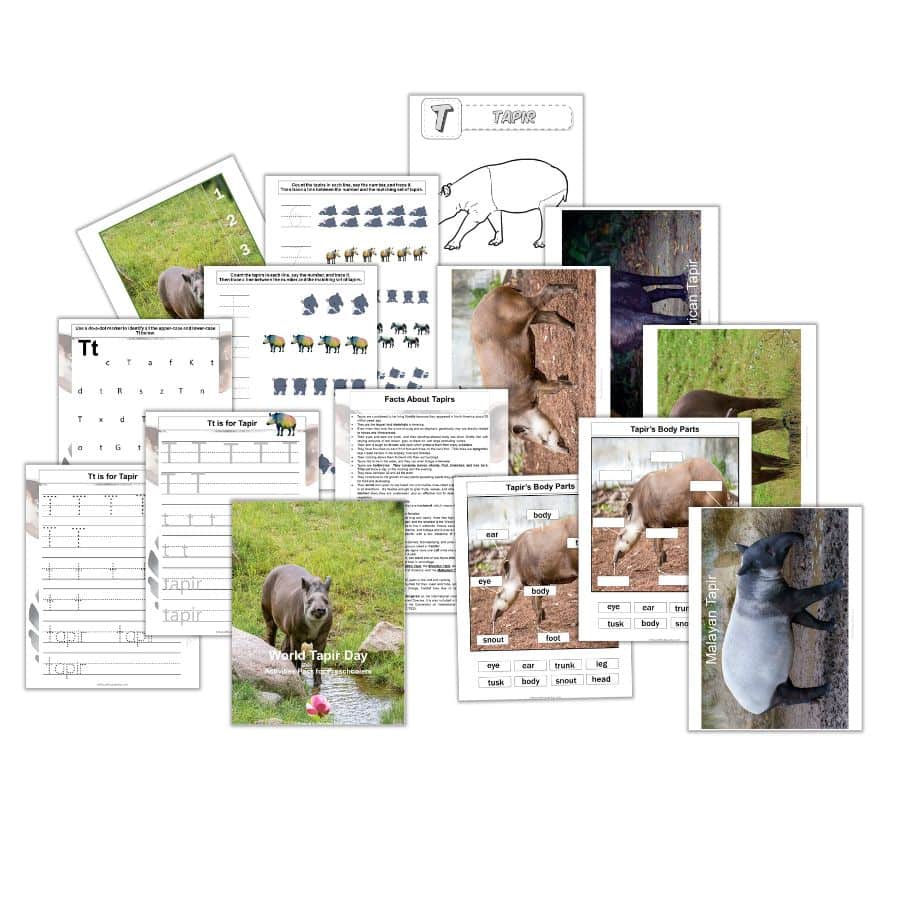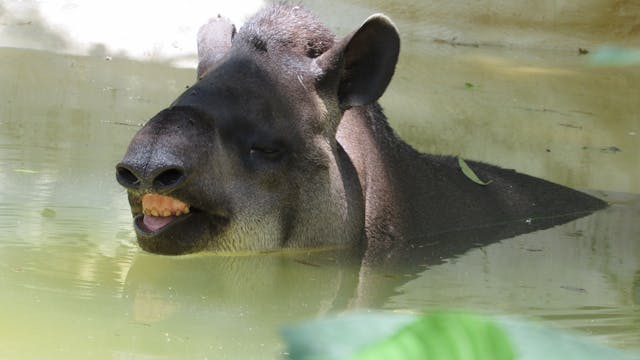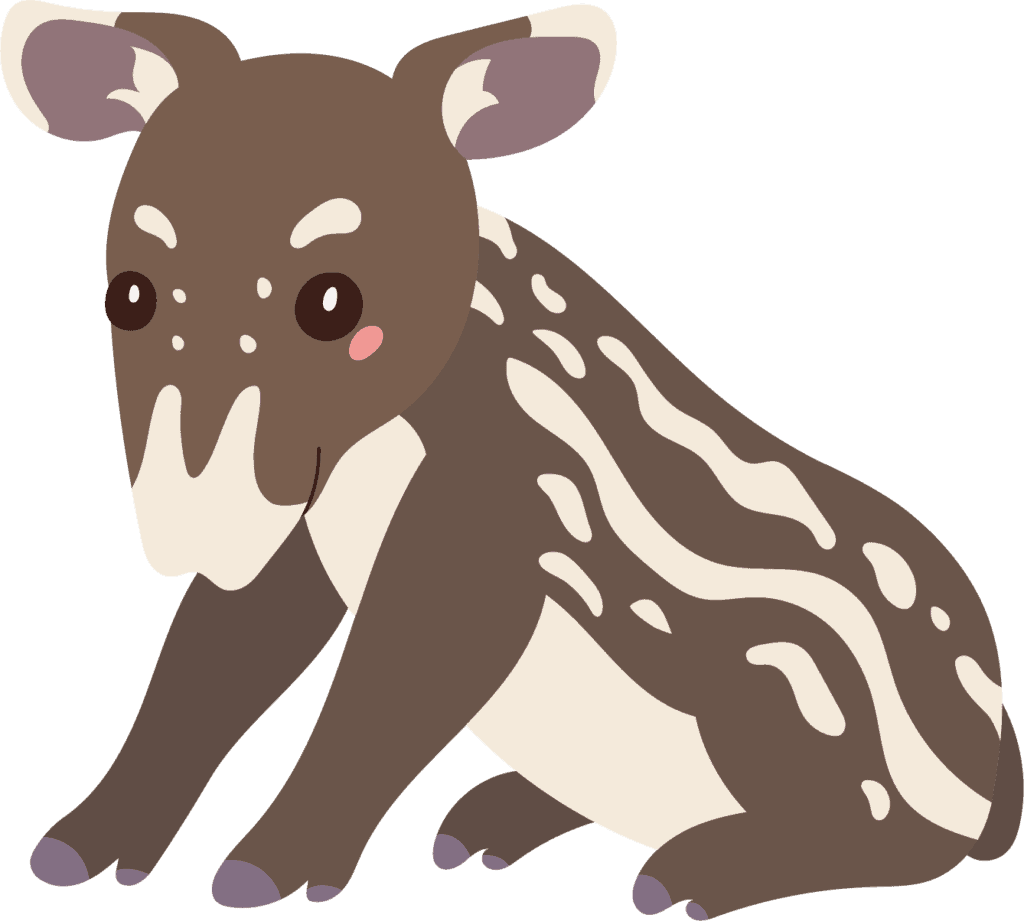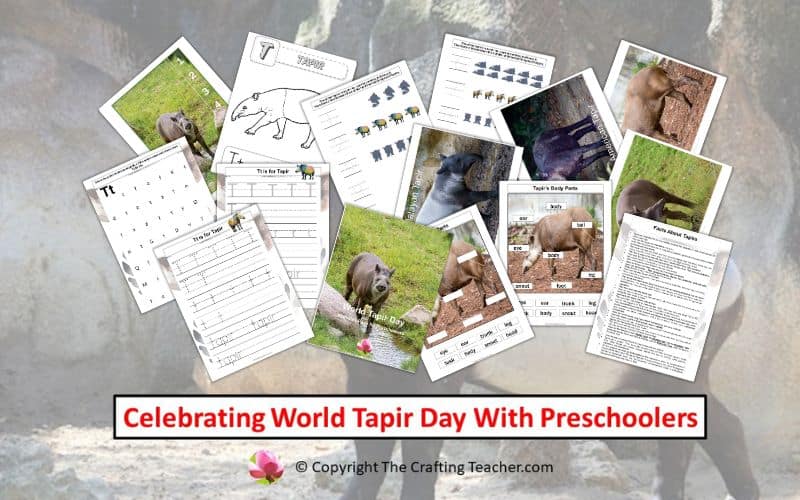Celebrating World Tapir Day With Preschoolers
Affiliate Disclosure: “This post contains affiliate links, which means I receive a small commission, at no extra cost, if you make a purchase using those links.”
World Tapir Day is celebrated every year on April 27 to raise awareness and educate about unique mammals included among critically endangered species, advocate for their protection to avoid their extinction, and raise funds to support conservation efforts.

I have included a FREE 17-page long World Tapir Day activities pack that includes Literacy, Science, Math, and Fine Motor activities for your preschoolers, which can be downloaded at the end of this post.
History of World Tapir Day
Tapir lovers and conservationists from around the world banded together to establish this special animal day, to educate people about the importance of sustaining healthy ecosystems, and the serious threats that these tapirs are facing, due to habitat loss and being hunted, which has caused all four tapir species are now listed as vulnerable or endangered.
With their call to action, they motivated zoos, other conservationists, and wildlife organizations worldwide to get involved and create educational programs, host events, and use campaigns to spread the word across the globe.
What started as a simple effort has grown into a global multi-step campaign to protect our planet’s biodiversity and avoid the extinction of these interesting mammals and other endangered species, for future generations to get to know them as well.
Today, worldwide organizations such as Fondation Segré World Tapir Conservation Programme and the IUCN Tapir Specialist Group, have created special projects such as the Guatemala Baird’s Tapir Conservation Programme, the Nicaragua Baird’s Tapir Project, the New Conservation Assessment of Mountain Tapirs in Colombia, the Lowland Tapir Conservation Initiative (LTCI), the Conservation of Malayan Tapirs, and the Fragmented Landscapes Project in Sumatra, San Diego Zoo Wildlife Alliance, and the Brevard Zoo, LTCI, are using technology, GPS collars, cameras, best management practices, research, biological and genetics studies, and other resources to protect fragmented landscapes and the biomes where the tapirs live, sharing this information with local communities and offering financial solutions to create partnerships and help them coexists better with these animals.
Facts About Tapirs
- Tapirs are considered to be living fossils because they appeared in North America about 55 million years ago.
- They are the largest land mammals in South America.
- Even when they look like a mix of a pig and an elephant, genetically they are directly related to horses and rhinoceroses.
- Their eyes and ears are small, and their teardrop-shaped body has short, bristle hair with varying amounts of red, brown, gray, or black fur, with large protruding rumps.
- Their skin is tough on its back and neck which protects them from many predators.
- They have four toes on each front foot and three on the back foot. Their toes are splayed to help create traction in mud and hillsides.
- Their coloring allows them to blend into their surroundings.
- Tapirs like to be in the water and they can even forage underwater.

- Tapirs are herbivores. They consume leaves, shoots, fruit, branches, and tree bark. They eat twice a day, in the morning and the evening.
- They have between 42 and 44 flat teeth.
- They contribute to the growth of new plants spreading seeds they eat when they are looking for food and defecating.
- Their snout and upper lip are fused into a trunk-like nose called a proboscis that can move in all directions. It’s flexible enough to grab fruits, leaves, and other food items, used as a snorkel when they are underwater, and an effective tool to detect odors through dense vegetation.
- They have stubby tails and short legs, and they can run through the bush pretty fast.
- They are also nocturnal, which means that they are more active during the night when is cooler.
- Depending on the species, they can reach more than six feet long, nearly three feet high, and weigh 400 to 800 pounds. The largest is the Malay tapir, and the smallest is the Wooly tapir. Male tapirs are slightly smaller than females.
- They are secretive animals that like to live in wetlands, forests, savannas, and rainforests with diverse and dense undergrowth, low incidence of fires, and undisturbed ecosystems. Three species live in Mexico, Central America, and South America. One species, the Malayan Tapir, lives in Malaya and Sumatra, in Southeast Asia.
- Tapirs can communicate using high-pitched sounds, foot stamping, and urine markings.
- They often graze in pairs or small groups called a candle.
- They have a low birth rate. Every two years, a female tapir has one calf while she stands, staying with her calf for more than a year.
- The calf is born with its eyes open, can stand one or two hours after birth, and has patterns with lines and spots on its body that help it camouflage.

- There are four species of tapir: Baird’s Tapir, the Brazilian Tapir, and the Mountain Tapir, distributed across South and Central America; and the Malayan Tapir, which is found in Southeast Asia.
- The Baird’s Tapir is also called the Central American Tapir, the Brazilian Tapir is also called Lowland Tapir or South American Tapir, and the Mountain Tapir is also called the Woolly Tapir.
- The Malayan Tapir is also called Asian Tapir, Asiatic Tapir, Oriental Tapir, Indian Tapir, Piebald Yapir, or Black-and-White Tapir.
- Their life span is between 20 and 30 years in the wild and captivity.
- Tapirs are in danger. They are hunted for their meat and hide, and even sport in Costa Rica. Other threats are climate change, habitat loss due to farming, cattle grazing, plantations, and development.
- All four species are listed as Endangered on the International Union for Conservation of Nature (IUCN) Red List of Threatened Species. It is also included in the List of Endangered Species of Guatemala (LEA), and the Convention on International Trade in Endangered Species of Wild Fauna and Flora (CITES).
How to Celebrate World Tapir Day
Tapirs are unknown to a lot of people worldwide, it is important that we learn about them, and spread the word to inform other people, especially our preschoolers. Participating in the events that World Tapir Day promotes, watching videos, posting on social media, going to the zoo to observe them in person, and using this opportunity to give important scientific lessons to our children will help preserve these amazing mammals.
Below are some ideas of activities you can do:
- Start by learning more about tapirs. You cannot teach what you don’t know. You should educate yourself to educate others.
- Print a tapir mask for each of your children and invite your children to dress up as a tapir with grey, black, or white and black clothes, and have a parade to create curiosity among the observers and use the opportunity to give them information.
- Plan tapir artwork for your children like the Tapir Printable Craft from Learn Create Love, or have your children create their drawings and paintings, and prepare an exhibit to share with the public or on social media, and include facts and information about tapirs.
- Show your children, family, and friends documentaries about tapirs. You can find some on YouTube like The Tale of the Tapir, TAPIRS: Nature’s Strange Swimming Submarine, What in the World is a Tapir? by National Geographic, and Tapirs by San Diego Zoo.
- Include tapir toys in your different areas, like this Malayan tapir, this baby tapir, and this Brazilian tapir. You also add stuffed tapirs like this one, this one, or this one.
- Research what activities and special events zoos and conservation organizations in your area are doing this day, and participate with your children and their families.
- Find out if your local zoo has a tapir exhibit, and plan a field trip with your children to observe these animals in person, and learn about them firsthand. If you cannot make it in person, research which zoos offer virtual tours, especially during World Tapir Day.
- Promote a symbolic tapir adoption with the National Wildlife Federation, the Hertfordshire Zoo, or the Zoo Society. These funds will help support the efforts of these organizations to protect tapirs, and other wildlife, promoting healthy ecosystems.
- Use your social media to spread awareness for tapirs by posting facts and promoting their conservation. You can use #WorldTapirDay, join the Word Tapir Day Facebook group, and follow the groups on Instagram and Twitter.
- Create a campaign to raise funds to support the organizations and projects that are fighting for tapir conservation. One way to do it is by inviting your families to purchase an item from the World Tapir Day store. There is pretty stuff in there.
Other Activities
- Help your children measure a tapir size in the playground, using pieces of strings or steps.
- Play “Follow the Tapir”, like you would “Follow the Leader”, or “Pig, Pig, Tapir” like you would “Duck, Duck, Goose“.
- Invite preschoolers to copy the names of the tapirs with pencils, markers, or crayons, or match them with magnetic, wooden, or foam letters.
- Have children spell the tapir names.
- Have them color a tapir with crayons or markers, or paint it with tempera paint.
- Add water, rainforest mini toys that include the tapir, pebbles, moss, and small branches to the sensory table, for the children to play with.
- Present pictures of tapirs and have them compare their characteristics.
- Have them find other words that have the same beginning sound.
- Have them find rhyming words.
- Have them clap the syllables of the tapir names.
- Invite an expert to come to the classroom and talk to your children about tapirs, and what we can do to help protect them.
Tapir-related Books
Never forget to read to your preschoolers. Listening to stories brings children in, sparks their interest, and helps them visualize and learn better. I have not been able to find many books related to tapirs, to be honest with you, but I wanted to include below the ones I use. I don’t know if you can find these books at your local library or used bookstore (maybe you can find different ones), but you definitely can find them at Amazon. I included my affiliate links to the titles, to make it easier for you to find the appropriate page.
- Can Tapir Play? by Sabina Gibson. This story presents a baby tapir sliding and rolling in the mud, tiger cubs learning to leap, and baby monkeys attempting to swing and climb.
- Facts About the Tapir by Lisa Strattin. This educational book presents facts, full-color photographs, and carefully chosen words to teach children about the Tapir.
- The Tapir Scientist: Saving the South America’s Largest Mammal by Sy Montgomery. In this nonfiction picture book, the author joins a tapir-finding expedition led by the Brazilian field scientist Pati Medici, and includes descriptions of fieldwork, and the use of high-tech science, to the tapir life.
- The Tapir. Do Your Kids Know About This? by Tanya Turner. This is a children’s picture book that teaches facts about tapirs.
Pin It For Later
If you are in a rush and don’t have time to read the post and download the printable but want to save it for later, pin it to one of your Pinterest boards for later.

Children must have a better knowledge of tapirs and other species that are in danger and you, as teachers and parents of preschoolers can encourage them to love, support, and protect these animals. This World Tapir Day make a vow to teach your children all of this, so they can become protectors and advocates for our planet and its inhabitants, so we all can have healthy ecosystems where every life thrives.
I hope you enjoy these ideas, and help you have fun during the World Tapir Day celebration with your preschoolers. To get the FREE pack, click on the link below and put your information, for an immediate download.
Be happy, safe, and creative. I wish you well.
Love,

P.D. Please let me know if any of these ideas worked for you, or if you came up with different ideas and want to share them, I would love to post them as well.







